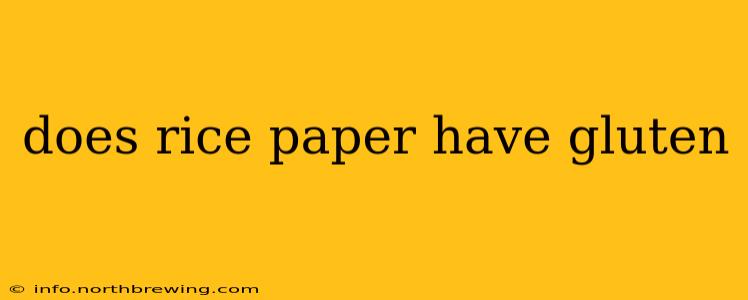Rice paper, a delicate and versatile ingredient used in numerous cuisines worldwide, is often lauded for its gluten-free nature. But is this always the case? Let's delve into the details to determine whether rice paper truly is a safe option for those following a gluten-free diet.
The simple answer is: typically, yes, rice paper is gluten-free. It's primarily made from rice flour and water, both of which are naturally gluten-free. However, the "typically" is crucial, and understanding the nuances is vital for maintaining a safe gluten-free lifestyle.
What is Rice Paper Made Of?
Rice paper's primary ingredients are rice flour and water. The rice flour is often made from glutinous rice (also known as sweet rice), which contributes to the paper's characteristic texture and flexibility. Some brands may also include other ingredients such as tapioca starch or potato starch, but these additions are usually also gluten-free.
Potential Sources of Gluten Contamination
While rice paper itself is naturally gluten-free, cross-contamination during manufacturing or packaging poses a significant risk. This is a key point often overlooked.
-
Manufacturing Facilities: If a facility produces both gluten-containing and gluten-free products on the same equipment, there's a risk of cross-contamination. This is especially true if the equipment isn't thoroughly cleaned between production runs.
-
Packaging and Handling: Packaging materials may have come into contact with gluten-containing products. Similarly, handling processes could introduce gluten if the same equipment is used for both gluten-containing and gluten-free products.
-
Added Ingredients: Although rare, some manufacturers might include additives or stabilizers that contain gluten. Always carefully check the ingredient list.
How to Ensure Your Rice Paper is Gluten-Free
To ensure you're consuming truly gluten-free rice paper, consider the following:
-
Check the Label Carefully: Look for a clear statement indicating that the product is certified gluten-free. This certification ensures that the product has met specific standards to minimize gluten contamination.
-
Choose Reputable Brands: Opt for brands known for their commitment to gluten-free production and rigorous testing. Researching brands beforehand can give you greater peace of mind.
-
Contact the Manufacturer: If you have any doubts or concerns about the manufacturing process or ingredients, don't hesitate to contact the manufacturer directly.
Is Rice Paper Always Safe for Celiac Disease Sufferers?
Even with certified gluten-free rice paper, individuals with celiac disease should exercise caution. Even trace amounts of gluten can trigger a reaction. It's always best to start with a small portion and monitor your reaction before consuming larger quantities.
What About "Gluten-Free" Claims?
Not all "gluten-free" claims are created equal. Some products might contain less than 20 ppm (parts per million) of gluten, which is considered gluten-free under certain regulations. However, this level may still cause a reaction for some individuals with celiac disease or severe gluten sensitivity.
FAQs:
What are the common ingredients in rice paper?
The main ingredients are rice flour (often glutinous rice flour) and water. Tapioca starch or potato starch might be included in some brands.
Can gluten-free rice paper be used for spring rolls?
Yes, gluten-free rice paper is perfectly suitable for making spring rolls and other similar dishes.
Are all rice papers created equal in terms of gluten content?
No, the manufacturing process and potential for cross-contamination can affect the gluten content of different brands. Always check the label.
Where can I buy certified gluten-free rice paper?
Many health food stores and online retailers specialize in gluten-free products and will stock certified gluten-free rice paper.
By carefully selecting your rice paper and paying close attention to labels and manufacturing processes, you can safely enjoy this versatile ingredient as part of a gluten-free diet. Remember that proactive steps are key to maintaining a safe and healthy eating plan.
